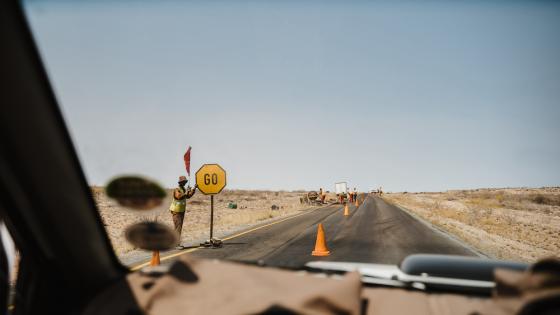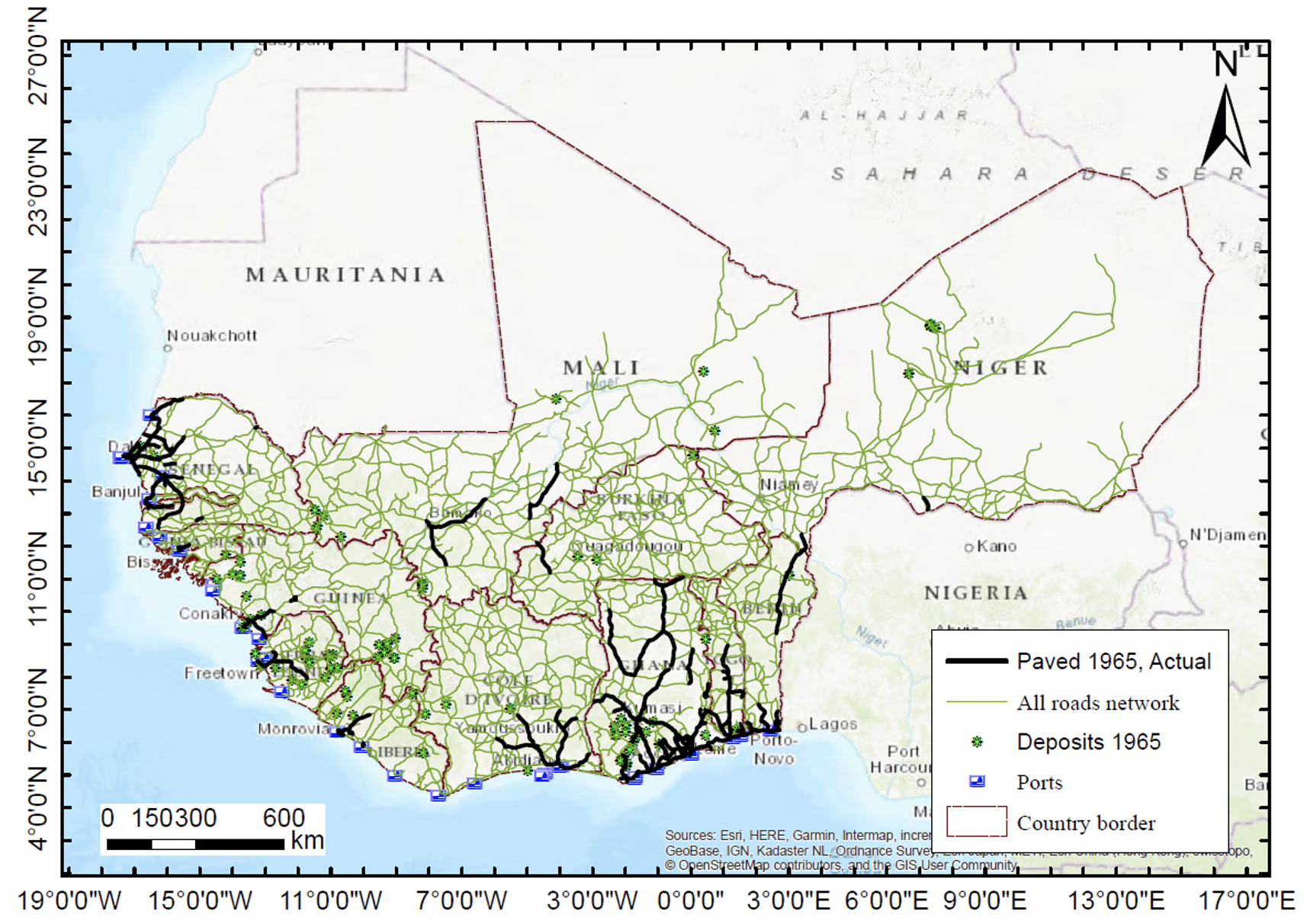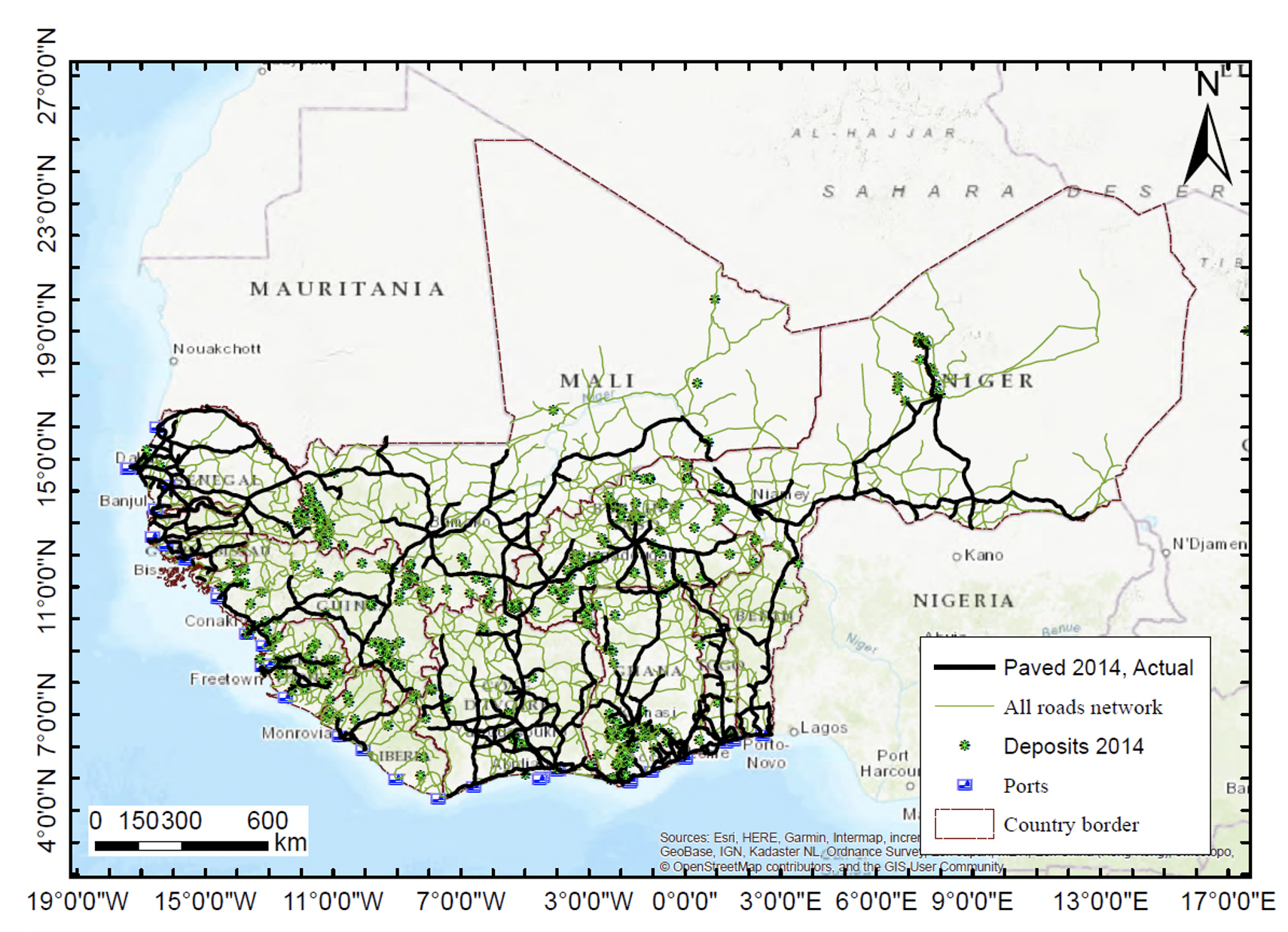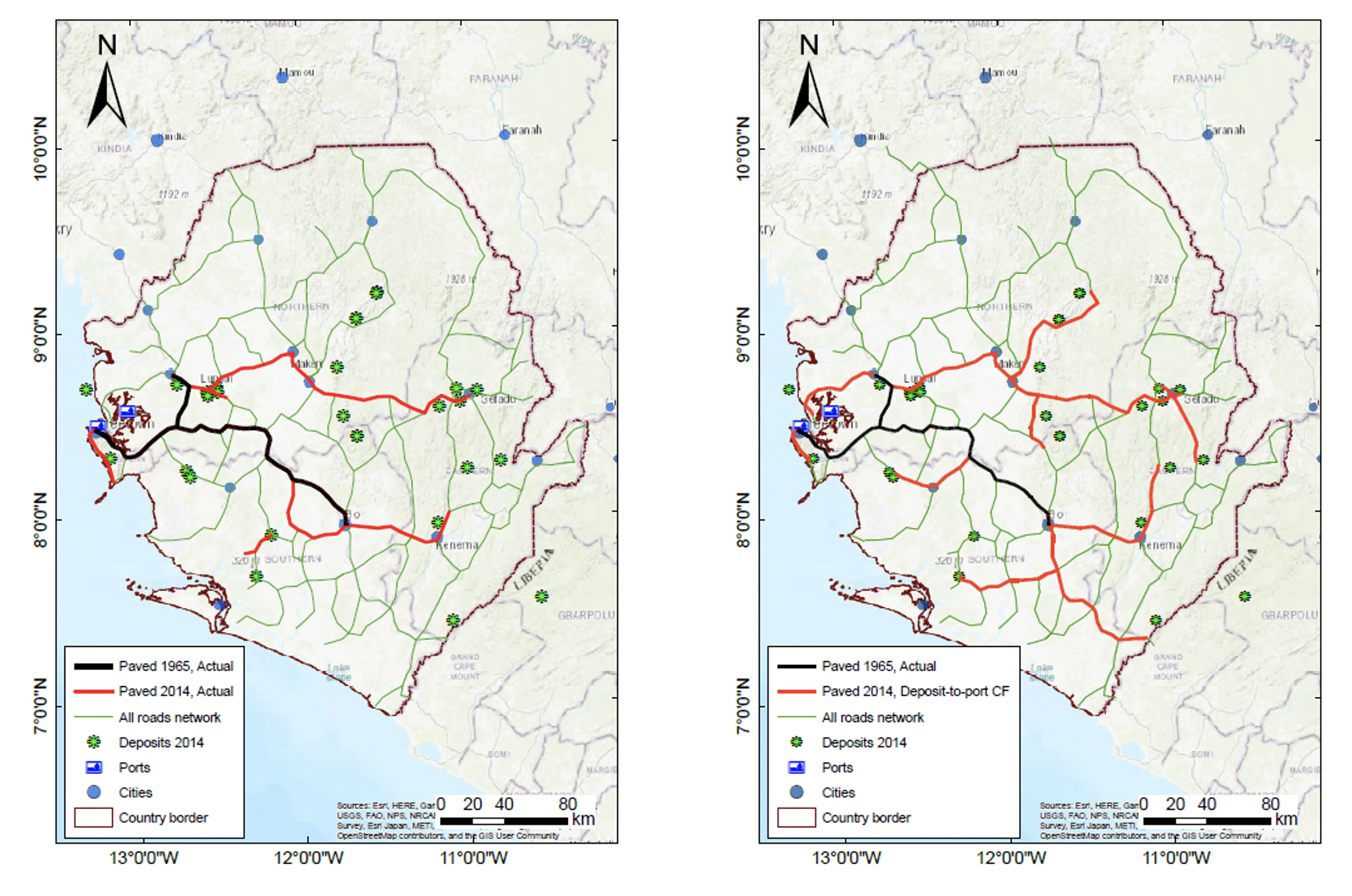One striking fact about Africa is that paved roads have evolved mostly in an interior-to-coast direction, and not only during colonial periods. Figures 1 and 2 illustrate this for 12 West African countries.
There were very few paved roads connecting neighbouring countries in 1965, particularly after excluding the interior-to-coast roads of the landlocked countries. This pattern remained clearly visible in the expanded paved network of 2014.
Figure 1 Paved roads in 1965 vs all roads in 2014
Figure 2 Paved roads in 2014 vs all roads in 2014
While interior-to-coast roads are useful to export natural resources and exploit that particular comparative advantage, they seem relatively ill-suited to promote internal and regional trade. In earlier work (Bonfatti and Poelhekke 2017), we showed that coastal African countries with more interior-to-port roads are strongly biased in favour of trade with overseas countries, relative to neighbouring countries. This effect is reversed for landlocked countries, presumably because the mine-to-port roads can also be used to trade with transit neighbours.
Indeed, internal trade costs remain much higher in Africa than in other parts of the world (Atkin and Donaldson 2015), and this is widely seen as a major obstacle to African development. For example, it hampers the modernisation of African agriculture (Blimpo et al. 2013: 62), whose low productivity and high labour share are found to explain most of the income gap between sub-Saharan Africa and the rest of the world (Porteous 2019).
Although the shape of African roads has long been criticised by policymakers and development economists (e.g. Nkrumah 1963: 23, Rodney 1972: 209, Sachs et al. 2004: 182), it has proven hard to establish that they are suboptimal. This is because the complexity of the optimal network-design problem, together with limited data availability, make it hard to identify the optimal network that the actual network should be compared with.
In a recent paper (Bonfatti et al. 2020), we take an indirect approach and investigate the political circumstances under which these networks were built. We assemble a new dataset of roads, metal and mineral deposits, ports and cities covering 12 West African countries over the period 1965–2014. The data on paved and unpaved roads were obtained by digitising 23 successive editions of Michelin road maps of West Africa so that we can track the expansion of the paved road network from period to period.
Comparing observed infrastructure decisions within each country over time – and thus keeping fixed the geography and the economic fundamentals that determine comparative advantage – we document that the West African paved road network expanded in a more interior-to-coast fashion in periods of autocracy, relative to periods of democracy. In particular, autocracies focused more on connecting metal and mineral deposits to ports (as opposed to any other pair of locations).
For example, Figure 3 shows Sierra Leone’s actual paving between 1965 and 2014 on the left, and a counterfactual network that would have been paved if governments only cared about connecting deposits to ports. The two networks are remarkably similar and become statistically more similar over time during autocratic periods. The effect we estimate is large: an increase of one standard deviation in autocracy results in an increase of a third of a standard deviation in deposit-to-port bias. Since deposits are typically located in a country’s interior and since autocracy was common, this resulted in more interior-to-coast roads.
Figure 3 Actual paving (left) vs counterfactual paving (right) in Sierra Leone
To address the concern that political regimes and road-paving decisions may be jointly determined, we focus on instances of regime change that were driven by external factors, as measured by the average state of democracy in the region (as suggested by Acemoglu et al. 2019).
We next turn to possible mechanisms. Our results are not driven by autocracies paving more kilometres than democracies, or by autocracies being more in favour of trade openness, or by the possibility that deposits and ports are simply close to big cities.
However, autocracies had a greater deposit-to-port bias when the deposits were predominantly located on the ruling elite’s ethnic homeland. This result squares well with earlier work on ethnic favouritism in African public policy. For example, Hodler and Raschky (2014) and Burgess et al. (2015) both provide evidence, respectively for a large sample of countries and for Kenya, that regions that were ethnically linked to the current leader received greater benefits. This was more true under autocracies than under democracies. Our results suggest that ethnic favouritism also involved policies to exploit natural resources, such as the construction of deposit-to-port roads.
This last finding suggests that the reason why autocratic African rulers focused on interior-to-coast roads was that they intended to appropriate the resulting resource rents for themselves and their ethnic group. Given the high prevalence of autocratic governments in this region and period and the considerable size of the effect we estimate, our results should go some way towards explaining the interior-to-coast shape of the West African networks. These networks should thus be seen not (or not only) as the appropriate response to geography or comparative advantage but also the result of corrupt politics.
The logical implication is that African countries should indeed take steps to re-balance their interior-to-coast networks in favour of interior-to-interior links. This should be kept in mind when evaluating current investment opportunities. For many years, the African Development Bank (e.g. 2003: 17) has been advocating a major expansion in Africa’s transport infrastructure, a large chunk of which should consist of long-distance, intra-African connections.
On the other hand, the lion’s share of recent investment has been taken up by China and its state-owned construction companies. In earlier work (Bonfatti and Poelhekke 2017), we took a closer look at these projects. We found that only five out of 40 projects connected two African countries with each other, which in four cases involved the connection of a landlocked country to the coast. Our results suggest that this may be the continuation of a suboptimal political process.
References
Acemoglu, D, S Naidu, P Restrepo and J A Robinson (2019), “Democracy does cause growth”, Journal of Political Economy 127(1): 47–100.
African Development Bank (2003), “Review of the implementation status of the trans African highways and the missing links – Volume 1: Main report”.
Atkin, D, and D Donaldson (2015), “Who’s getting globalized? The size and implications of intra-national trade costs”, NBER Working Papers 21439.
Blimpo, M P, R Harding and L Wantchekon (2013), “Public investment in rural infrastructure: Some political economy considerations”, Journal of African Economies 22(suppl 2): ii57–ii83.
Bonfatti, R, and S Poelhekke (2017), “From mine to coast: Transport infrastructure and the direction of trade in developing countries”, Journal of Development Economics 127: 91–108.
Bonfatti, R, Y Gu and S Poelhekke (2020), “Priority Roads: the Political Economy of Africa’s Interior-to-Coast Roads”, CEPR Discussion Paper 15354.
Burgess, R, R Jedwab, E Miguel, A Morjaria and G Padró i Miquel (2015), “The value of democracy: Evidence from road building in Kenya”, American Economic Review 105(6): 1817–51.
Hodler, R, and P A Raschky (2014), “Regional favoritism”, The Quarterly Journal of Economics 129(2): 995–1033.
Nkrumah, K (1963), Africa must unite, Heineman.
Porteous, O (2019), “High trade costs and their consequences: An estimated dynamic model of African agricultural storage and trade”, American Economic Journal: Applied Economics 11(4): 327–66.
Rodney, W (1972), How Europe underdeveloped Africa, Bogle-L’Ouverture Publications.
Sachs, J, J W McArthur, G Schmidt-Traub, M Kruk, C Bahadur, M Faye and G McCord (2004), “Ending Africa’s poverty trap”, Brookings Papers on Economic Activity 2004(1): 117–240.





